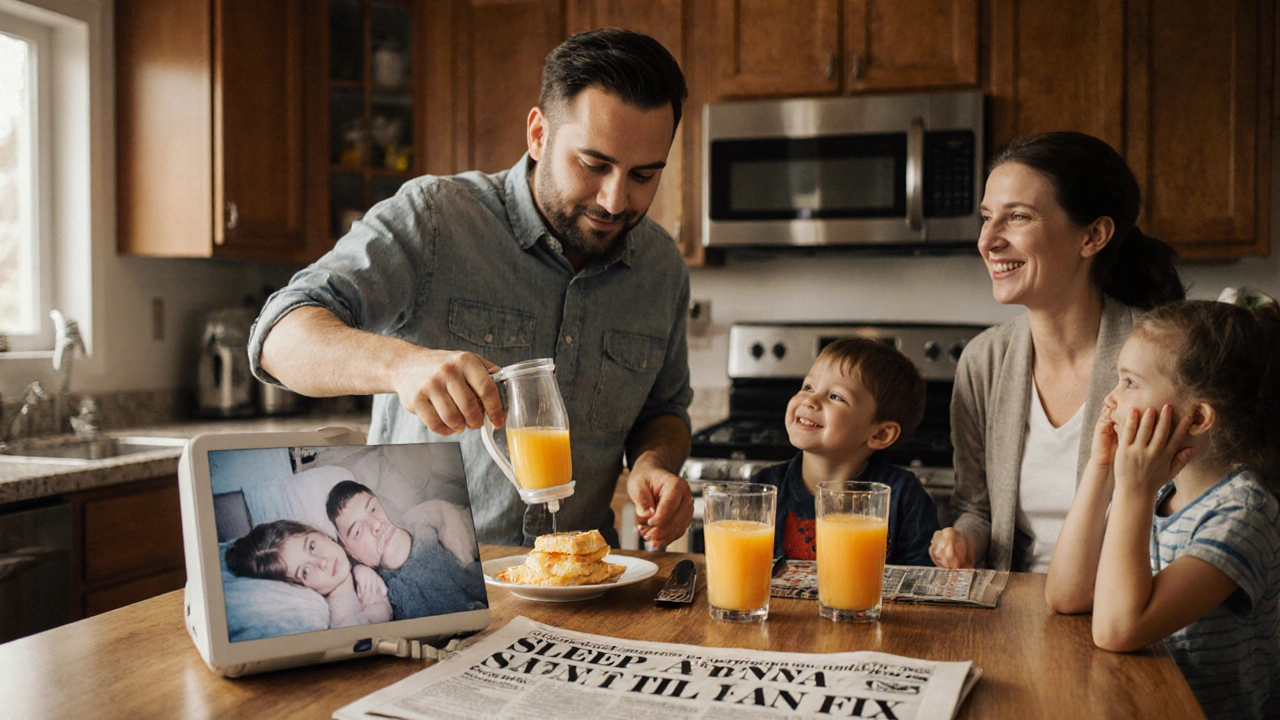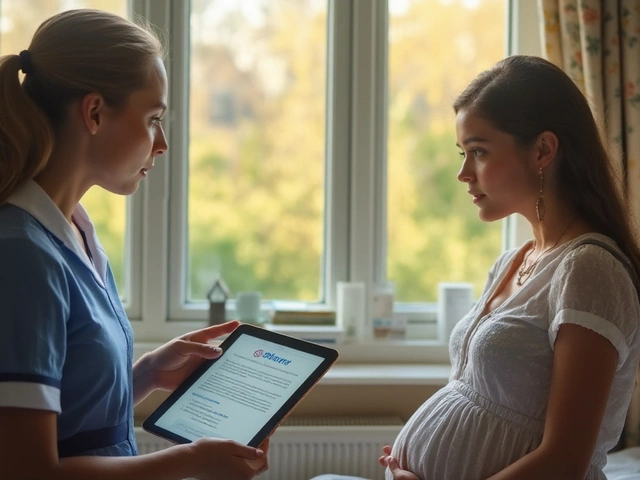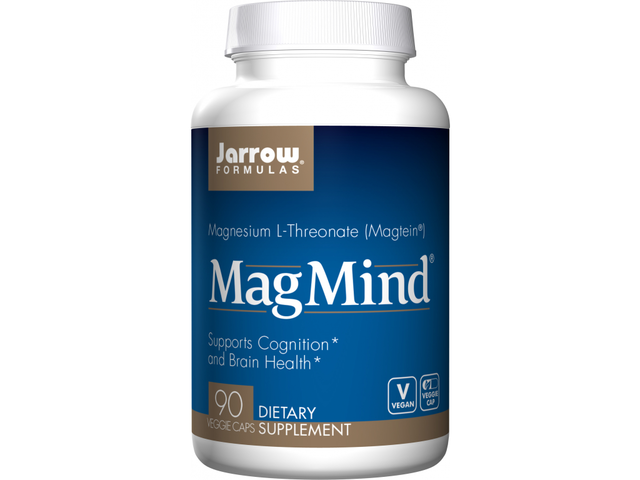What Happens When Sleep Apnea Leads to Respiratory Failure?
When you stop breathing repeatedly during sleep-sometimes dozens of times an hour-your body doesn’t just wake you up. It’s struggling to get oxygen. That’s obstructive sleep apnea (OSA). Over time, those drops in oxygen don’t just make you tired. They strain your heart, spike your blood pressure, and can push you into respiratory failure. This isn’t a rare outcome. Studies show that untreated moderate to severe OSA increases the risk of acute respiratory failure by nearly 40% in people with existing lung or heart conditions.
Many people think oxygen therapy alone fixes this. But giving more oxygen without fixing the airway collapse is like pouring water into a leaky bucket. The real solution? Keeping the airway open while supporting oxygen levels. That’s where CPAP comes in.
How CPAP Actually Works-And Why It’s Still the Gold Standard
Introduced in 1981, CPAP (Continuous Positive Airway Pressure) isn’t fancy. It’s a machine that blows slightly pressurized air through a mask. That pressure acts like a splint, holding your throat open so you can breathe all night. No snoring. No gasping. No oxygen drops.
For someone with an apnea-hypopnea index (AHI) of 30-40 events per hour, CPAP cuts that number to under 5 in 90% of people who use it regularly. That’s not a small change. That’s a life-saving one. The American Academy of Sleep Medicine and the American Thoracic Society both list CPAP as the first-line treatment for moderate to severe OSA. It’s not just a recommendation-it’s the standard.
But here’s the catch: CPAP only works if you use it. Studies show adherence rates range from 17% to 85%. Why such a wide gap? It’s not about willpower. It’s about fit, comfort, and support. A 2022 survey found that patients who got in-person mask fitting and follow-up within 72 hours had a 78% adherence rate at six months. Those who only got telehealth support? Just 46%.
Oxygen Therapy Alone Won’t Cut It for Sleep Apnea
Some doctors still prescribe supplemental oxygen for sleep apnea, especially if they see low oxygen levels on a sleep study. But oxygen doesn’t stop the airway from collapsing. It just tries to make up for the damage after it happens.
In one study, patients using oxygen therapy alone still had over 20 apnea events per hour-even with extra oxygen flowing. Their blood oxygen improved slightly, but their sleep stayed fragmented. Their blood pressure didn’t drop. Their risk of heart attack didn’t go down.
CPAP fixes the root cause. Oxygen therapy is a bandage. For people with true OSA, CPAP is the cure. Oxygen might be added in rare cases-like when someone has both OSA and severe COPD-but it’s never the main treatment. The American Thoracic Society made this clear in their 2022 guidelines: oxygen without airway support doesn’t reduce cardiovascular risk in OSA patients.
CPAP vs. BiPAP vs. APAP: Which One Is Right for You?
Not all PAP devices are the same. Here’s how they differ:
- CPAP: Delivers one fixed pressure all night. Best for simple OSA without other lung diseases.
- BiPAP (Bilevel PAP): Uses two pressures-a higher one when you inhale, a lower one when you exhale. Helps people who struggle to breathe out against high pressure, or those with neuromuscular disorders or COPD.
- APAP (Auto-titrating PAP): Adjusts pressure automatically based on your breathing each night. Good for people whose needs change-like if you gain weight, sleep on your back, or have occasional central apneas.
For most people with pure OSA, CPAP is enough. But if you’re struggling with high pressure, feeling short of breath, or have heart failure or COPD, BiPAP may be better. APAP is great if your apnea severity varies from night to night. A 2023 study showed APAP was just as effective as fixed CPAP for patients without major comorbidities.

Why People Quit CPAP-And How to Stick With It
Four out of ten people stop using CPAP within the first year. The biggest reasons? Mask discomfort, dry mouth, claustrophobia, and noise. But these aren’t deal-breakers-they’re solvable problems.
Here’s what works:
- Mask type: Nasal pillows (small prongs in the nose) are preferred by 73% of users. Full-face masks are better if you breathe through your mouth.
- Humidification: Heated humidifiers reduce dryness and irritation. Over 70% of users who stick with CPAP say humidification made the difference.
- Chin straps: If you’re losing air through your mouth, a simple chin strap stops leaks without switching masks.
- Gradual acclimation: Start with 2-3 hours a night. Increase by 30 minutes each week. Don’t try to use it all night on day one.
- Follow-up care: A 30-minute setup with a sleep tech, plus a check-in at 72 hours and again at 30 days, boosts adherence by 32%.
Reddit users on r/CPAP say the biggest win? Realizing they feel like a new person after two weeks. Sixty-eight percent of users on MyApnea.org reported better alertness and mood within that time.
What About New Alternatives to CPAP?
There’s a new player: the hypoglossal nerve stimulator (Inspire). It’s a small implant that gently stimulates the nerve controlling your tongue, keeping your airway open. In a 2023 trial, 79% of patients stuck with it after a year-far higher than CPAP’s 46%.
But it’s not for everyone. You need to be a good candidate: not obese, no severe central sleep apnea, and able to tolerate general surgery. It also costs over $30,000, and insurance coverage is limited.
CPAP still wins for most people because it’s non-invasive, reversible, and works for nearly all types of OSA. The implant is an option if CPAP fails, not a replacement.
When Respiratory Failure Is Already Here-CPAP and NIV Save Lives
Respiratory failure doesn’t always mean you’re in the ER. Sometimes it’s slow: rising carbon dioxide levels, worsening fatigue, morning headaches. In these cases, non-invasive ventilation (NIV)-often BiPAP-is the first line of defense.
For people with COPD or obesity hypoventilation syndrome, NIV can prevent intubation. Studies show it reduces the need for breathing tubes by 20-30% during flare-ups. If your blood pH drops below 7.35 or your CO2 climbs above 50 mmHg, NIV should be started immediately.
Here’s what success looks like: within 1-4 hours, your pH should rise and your CO2 should fall. If it doesn’t, you may need to go on a ventilator. Delaying NIV beyond six hours in acute failure increases 30-day mortality by 28%, according to a 2021 cohort study.

Insurance, Costs, and What’s Covered in 2025
Medicare pays $209.74 per month for CPAP equipment in 2025. Most private insurers cover it too-but they’re watching your usage. Since 2022, 45% of U.S. insurers require proof of use: at least 4 hours a night, on 70% of nights, to keep covering the device.
That’s not just bureaucracy. It’s based on data. If you’re not using it enough, your body isn’t healing. Insurance companies aren’t being harsh-they’re trying to make sure you get real benefit.
Devices from ResMed and Philips are the most common. Philips had a major recall in 2021 due to foam degradation in older models. Newer devices are FDA-cleared with safer materials. Always check your model number if you’re using an older machine.
What’s Next? Personalized Sleep Therapy Is Coming
The old rule-“use CPAP 4 hours a night”-is changing. New guidelines from the American Academy of Sleep Medicine (2024 preview) say adherence goals should be personal. One person might need 5 hours to feel alert. Another might feel fine after 3.5 hours if their AHI is under 3 and their oxygen stays above 90%.
Remote monitoring is making this possible. Most new CPAP machines now connect to apps that track your usage, leaks, and even how many events you had. Doctors can adjust pressure without you coming in. ResMed’s AirView platform cut follow-up visits by 27% in a 2022 study.
But technology alone won’t fix adherence. Human support still matters. The sleep centers that use teams-respiratory therapists, sleep coaches, mental health counselors-see 22% higher adherence than clinics that just hand out machines.
Final Thoughts: CPAP Isn’t Perfect-But It’s Essential
Sleep apnea isn’t just about snoring. It’s about oxygen, heart health, brain function, and survival. CPAP doesn’t cure it overnight. It takes patience, the right mask, and support. But for millions, it’s the difference between living with exhaustion and living well.
Oxygen therapy has its place-but only as a helper, not the hero. If you’re struggling with CPAP, don’t give up. Talk to your provider. Try a different mask. Add humidification. Use a chin strap. Adjust slowly. You’re not failing. The system might just need tweaking.
And if you’re facing respiratory failure? CPAP or BiPAP could be the thing that keeps you off a ventilator. That’s not a guess. That’s science.
Can oxygen therapy treat sleep apnea on its own?
No. Oxygen therapy can improve blood oxygen levels during sleep apnea episodes, but it doesn’t stop the airway from collapsing. That’s the root cause of obstructive sleep apnea. Without keeping the airway open, breathing interruptions continue, sleep stays fragmented, and long-term risks like high blood pressure and heart failure remain. CPAP is the only treatment that addresses the mechanical blockage. Oxygen may be added in rare cases-like for patients with both OSA and severe COPD-but it’s never used alone for OSA.
How long does it take to feel better after starting CPAP?
Most people notice improvements in daytime alertness, mood, and concentration within 1 to 2 weeks of consistent use. One survey of 12,500 CPAP users found that 68% reported feeling more awake and less fatigued after just two weeks. However, full benefits-like lower blood pressure and improved heart function-take months. The key is consistency: using the device every night, even if you don’t feel immediate results.
Is CPAP the only treatment for severe sleep apnea?
CPAP is the first-line and most effective treatment for severe sleep apnea, but it’s not the only option. Mandibular advancement devices (MADs) can help mild to moderate cases but are less effective for severe apnea. For people who can’t tolerate CPAP, a hypoglossal nerve stimulator (like Inspire) is an FDA-approved surgical alternative that stimulates the tongue to keep the airway open. It has higher long-term adherence rates but requires surgery and isn’t suitable for everyone-especially those who are overweight or have central sleep apnea. CPAP remains the standard because it’s non-invasive, adjustable, and works for nearly all cases.
What’s the difference between CPAP and BiPAP?
CPAP delivers one constant pressure throughout the breathing cycle. BiPAP (bilevel PAP) gives two different pressures: a higher one when you inhale (IPAP) and a lower one when you exhale (EPAP). This makes breathing out easier, which helps people who struggle with high CPAP pressure, have COPD, neuromuscular disease, or heart failure. BiPAP is also used for central sleep apnea and respiratory failure. If you feel short of breath or exhausted trying to exhale against CPAP, BiPAP may be a better fit.
Why do some insurance companies require proof of CPAP use?
Insurance companies require proof-typically 4 hours of use per night on 70% of nights-because studies show that’s the minimum needed to get clinical benefits. If you’re not using it enough, your blood pressure won’t drop, your risk of heart attack won’t decrease, and your sleep won’t improve. This policy isn’t meant to punish you-it’s to make sure the treatment is actually working. Most devices now automatically track usage and send data to your provider, so you don’t have to manually report it.
Can CPAP prevent respiratory failure?
Yes, especially in people with chronic conditions like COPD or obesity hypoventilation syndrome. Regular CPAP or BiPAP use prevents the buildup of carbon dioxide and drops in oxygen that lead to respiratory failure. In acute situations-like a COPD flare-up-non-invasive ventilation (NIV) using BiPAP can prevent the need for intubation by 20-30%. For people with untreated severe sleep apnea, long-term CPAP use reduces the risk of developing respiratory failure by stabilizing breathing patterns and improving lung function over time.
What should I do if my CPAP mask leaks or feels uncomfortable?
Mask leaks and discomfort are the top reasons people quit CPAP-but they’re fixable. First, try a different mask type: nasal pillows often work better than full-face masks for people who feel claustrophobic. Use a heated humidifier to reduce dryness and irritation. If you’re breathing through your mouth, try a chin strap. Adjust the straps gently-tighter isn’t better, and over-tightening causes leaks. If problems persist, schedule a follow-up with your sleep clinic. Many providers offer mask fittings and pressure adjustments at no extra cost. Don’t suffer in silence; there’s almost always a better fit.
Does using CPAP help with heart problems?
Yes, for many people. CPAP lowers systolic blood pressure by 2.5 to 5 mmHg on average in people with sleep apnea. It also improves heart rhythm, reduces strain on the heart muscle, and can increase left ventricular ejection fraction by 4-6% in patients with heart failure and OSA. However, the SAVE trial found no cardiovascular benefit in non-sleepy patients with existing heart disease. This means CPAP helps most when you have symptoms like daytime sleepiness or fatigue. If you’re sleepy and have OSA, CPAP can protect your heart. If you’re not sleepy, the benefit may be smaller.







Rachel Puno
7 November 2025I was skeptical at first, but after two weeks of consistent CPAP use, I woke up feeling like I’d slept for eight hours instead of three. No more afternoon crashes. No more brain fog. My wife says I stopped snoring like a chainsaw. It’s not glamorous, but it’s life-changing.
Start slow. Don’t try to wear it all night on day one. Build up. You’ll thank yourself.
Steve Phillips
9 November 2025CPAP? Please. It’s 2025. We’ve got AI-driven nasal splints, smart inhalers, even subcutaneous nerve stimulators-and you’re still shoving a plastic mask on your face like it’s 1998?
It’s not just outdated-it’s a cultural relic. The fact that insurance still mandates 4 hours a night is laughable. My BiPAP’s app tracks my REM cycles better than my ex tracked my whereabouts. Stop glorifying the bucket. Fix the leak.
Meghan Rose
9 November 2025I read somewhere that oxygen therapy alone can help if you’re hypoxic-but that’s only if you don’t have OSA. Wait, no-actually, the paper said it’s useless for OSA. But then I saw a TikTok from a doctor who said it works for elderly patients with COPD. So which is it? I’m confused now.
Also, my mask leaks when I roll over. I think it’s the wrong size. Or maybe I’m just bad at this.
Clyde Verdin Jr
10 November 2025CPAP is a cult. A cult of silence and silicone. People worship it like it’s the second coming of Jesus with a humidifier.
And yet-half the people on r/CPAP are still crying about dry mouth and claustrophobia. If you can’t handle a mask, maybe you’re not meant to be alive at 3 a.m. breathing through a tube. Just sayin’. 😒
Brad Seymour
11 November 2025I’ve been using CPAP for 7 years. Started with a full-face mask, hated it. Switched to nasal pillows after my sleep tech gave me a free trial set. No more red marks. No more leaks.
And yes, the humidifier made all the difference. I used to wake up with a cotton mouth every morning. Now? I feel like I just got back from a vacation. No drama. Just results.
Cris Ceceris
12 November 2025I wonder if we’re treating the symptom instead of the cause. Why does the airway collapse? Is it just anatomy? Or is it inflammation? Or maybe it’s the way we sleep? We’ve got machines that hold it open-but what if we could train the body to keep it open naturally?
What if the real cure isn’t in the machine, but in the way we live? I’m not saying ditch CPAP. I’m just asking… is there more?
Malia Blom
14 November 2025Let’s be real-CPAP is a Band-Aid on a bullet wound. They sell you this machine like it’s a miracle, but what about the root? Obesity? Poor posture? Alcohol? Sleep deprivation? We’re just patching up the consequences while ignoring the damn cause.
And don’t get me started on the $30k implant. That’s not innovation. That’s capitalism with a pulse.
Erika Puhan
15 November 2025The data is clear: oxygen therapy without airway support is clinically meaningless. AHI >20, SpO2 <88%, elevated CO2-these are biomarkers of systemic failure. You don’t treat hypoxemia with O2 if the obstruction persists. That’s not medicine. That’s negligence.
And yet, 37% of primary care docs still prescribe it. The system is broken. You’re not lazy-you’re being failed.
Edward Weaver
17 November 2025CPAP is fine for Americans who can afford it. But in real countries, people don’t have $200/month machines. They don’t have sleep clinics. They have a fan, a pillow, and a prayer.
Why don’t we talk about the real issue? Healthcare inequality. Not whether your mask fits. Not whether you used it 70% of nights. The system is rigged.
Lexi Brinkley
18 November 2025I got my CPAP last year and I’m obsessed 🤩✨
My app tells me I slept 7.2 hours last night with 0 apneas. I’m basically a superhero now. Also, I named my machine Steve. He’s my bestie. 💖💤
Kelsey Veg
20 November 2025i hate my cpap so much its like a plastic torture device and i keep taking it off at night but then i wake up like a zombie so idk what to do
Alex Harrison
20 November 2025i tried cpap for a week and it was rough. dry mouth, noise, felt like i was wearing a space helmet. but i stuck with it. switched to nasal pillows, got a humidifier, and now i dont even think about it. its just part of my routine. dont give up. it gets better.
Jay Wallace
22 November 2025CPAP? Please. I saw a documentary where they used a $1500 implant in Norway and patients were sleeping like babies. Meanwhile, Americans are still fighting over mask straps like it’s a 1950s marriage. We’re behind. Way behind.
Also, why is ResMed the only brand that matters? Are we in a monopoly or a medical system?
Alyssa Fisher
23 November 2025There’s a quiet revolution happening in sleep medicine. We’re moving from one-size-fits-all to personalized thresholds. Some people need 5 hours of CPAP to feel rested. Others feel fine after 3.5.
It’s not about hitting a number-it’s about how you feel. Your body knows. The machine just helps it remember. That’s the real breakthrough.
Key Davis
24 November 2025The American Academy of Sleep Medicine’s 2024 guidelines represent a paradigm shift in clinical practice. Adherence metrics are no longer rigidly quantified; instead, they are contextualized within individual physiological and psychosocial parameters. This evolution reflects a mature, patient-centered approach to chronic disease management.
It is imperative that clinicians prioritize longitudinal support systems-including respiratory therapists, behavioral counselors, and telehealth integration-to optimize outcomes. Technology alone cannot substitute for human compassion.